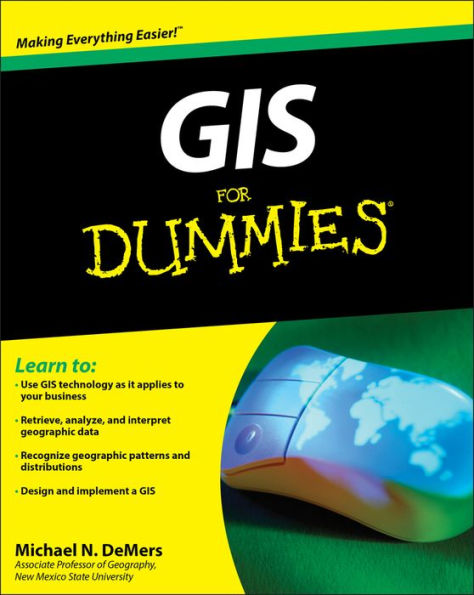GIS (geographic information system) is a totally cool technology that has been called "geography on steroids." GIS is what lets you see the schools in your neighborhood or tells you where the nearest McDonald's is. GIS For Dummies tells you all about mapping terminology and digital mapping, how to locate geographic features and analyze patterns such as streets and waterways, and how to generate travel directions, customer location lists, and much more with GIS.
Whether you're in charge of creating GIS applications for your business or you simply love maps, you'll find GIS For Dummies is packed with information. For example, you can:
- Learn all the hardware and software necessary to collect, analyze, and manipulate GIS data
- Explore the difference between 2D and 3D maps, create a map, or manage multiple maps
- Analyze patterns that appear in maps and interpret the results
- Measure distance in absolute, comparative, and functional ways
- Recognize how spatial factors relate to geographic data
- Discover how GIS is used in business, the military, city planning, emergency services, land management, and more
- Find out how GIS can help you find discover where flooding may occur
- Determine what your organization needs, do appropriate analyses, and plan and design a GIS system
You'll find dozens of applications for GIS queries and analyses, and even learn to create animated GIS output. Additionally, you can learn about sources of GIS data and GIS software vendors (and even what questions to ask potential vendors). Whether your goal is to implement a geographic information system or just have fun, GIS For Dummies will get you there!
GIS (geographic information system) is a totally cool technology that has been called "geography on steroids." GIS is what lets you see the schools in your neighborhood or tells you where the nearest McDonald's is. GIS For Dummies tells you all about mapping terminology and digital mapping, how to locate geographic features and analyze patterns such as streets and waterways, and how to generate travel directions, customer location lists, and much more with GIS.
Whether you're in charge of creating GIS applications for your business or you simply love maps, you'll find GIS For Dummies is packed with information. For example, you can:
- Learn all the hardware and software necessary to collect, analyze, and manipulate GIS data
- Explore the difference between 2D and 3D maps, create a map, or manage multiple maps
- Analyze patterns that appear in maps and interpret the results
- Measure distance in absolute, comparative, and functional ways
- Recognize how spatial factors relate to geographic data
- Discover how GIS is used in business, the military, city planning, emergency services, land management, and more
- Find out how GIS can help you find discover where flooding may occur
- Determine what your organization needs, do appropriate analyses, and plan and design a GIS system
You'll find dozens of applications for GIS queries and analyses, and even learn to create animated GIS output. Additionally, you can learn about sources of GIS data and GIS software vendors (and even what questions to ask potential vendors). Whether your goal is to implement a geographic information system or just have fun, GIS For Dummies will get you there!

GIS For Dummies
384
GIS For Dummies
384Related collections and offers


Product Details
| ISBN-13: | 9780470521502 |
|---|---|
| Publisher: | Wiley |
| Publication date: | 03/25/2009 |
| Series: | For Dummies Books |
| Sold by: | JOHN WILEY & SONS |
| Format: | eBook |
| Pages: | 384 |
| File size: | 4 MB |
